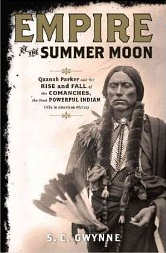
Quanah Parker
Post Cemetery
Ft. Sill, Oklahoma

Quanah Parker
Post Cemetery
Ft. Sill, Oklahoma
The inscription on the obelisk reads:
RESTING HERE UNTIL DAY BREAKS
AND SHADOWS FALL AND DARKNESS
DISAPPEARS IS
QUANAH PARKER
LAST CHIEF OF THE COMANCHES
BORN - 1852
DIED FEB. 23, 1911
________
THIS MONUMENT ERECTED UNDER ACT OF CONGRESS
APPROVED JUNE 23, 1926
Quanah Parker, though perhaps not as well-known as Sitting Bull or Geronimo (both are also in the 101 Bananas Graveyard), was a famous American Indian who lived during a crucial time for the Comanche Indians of the Southwest. Parker led one of the several bands of Comanche through their last years of freedom on the plains, a time of constant war with other tribes, white settlers moving west, the Texas Rangers, and the U.S. Army. When he realized the certain inevitability of the Indian’s defeat at the hands of overwhelmingly superior numbers and firepower, he was instrumental in bringing the last of the Comanches onto the reservation in Oklahoma.
He was later appointed spokesman, or "Chief", of all of the Comanche on the reservation, eventually becoming a successful rancher, well-known and influential in U.S./Indian affairs. President Theodore Roosevelt is said to have visited and gone wolf-hunting with him once.
Parker was the son of a Comanche chief and a white woman, Cynthia Ann Parker, whose own story is one of the most famous “captivity narratives” of the American West. Cynthia Parker was captured by Indians in 1836 at the age of nine, grew up with them and married a Comanche chief. Quanah was her first child. She was re-captured many years later at the age of 34 by the Texas Rangers and returned, against her will, to her family. She never re-adapted to white civilization and tried to escape back to her Indian life several times. She died a decade after her return. Cynthia Parker and her daughter Prairie Flower, Quanah’s sister, are buried next to Quanah at Ft. Sill.

Empire of the Summer Moon: Quanah Parker and the Rise and Fall
of the Comanches, the Most Powerful Indian Tribe in American History
Author S.C. Gwynne tells the story not just of Quanah Parker, but of the several bands of Comanche Indians who roamed (and ruled) large areas of the Great Plains and Texas in the last half of the 1800s. It is both an interesting historical document, and a social/cultural introduction to the Indians of the Southwest in that era. Anyone interested in the old days of the American West in general, or American Indians in particular, would enjoy this book. Highly recommended by the staff and management of 101 Bananas.